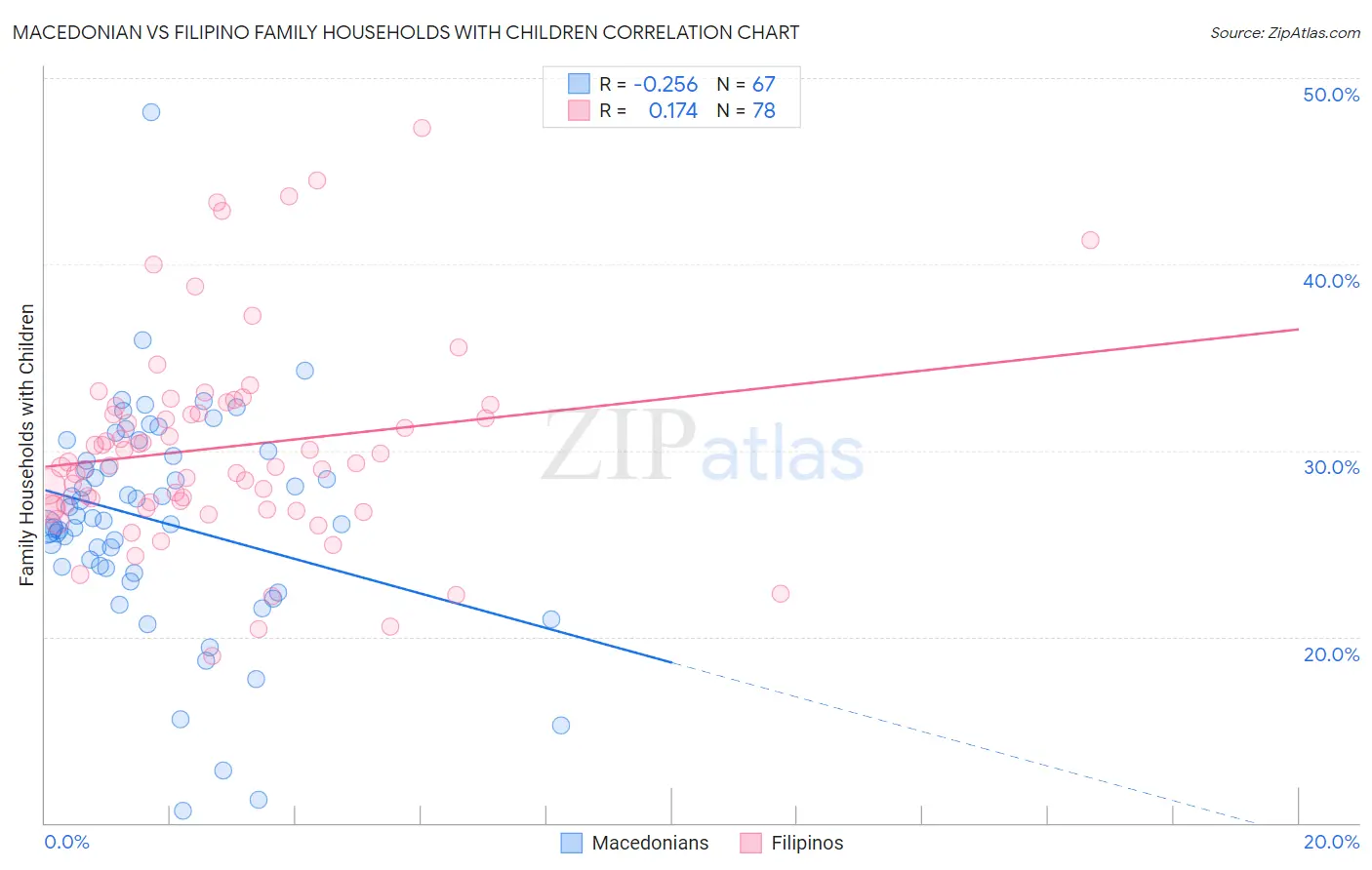Macedonian vs Filipino Family Households with Children
COMPARE
Macedonian
Filipino
Family Households with Children
Family Households with Children Comparison
Macedonians
Filipinos
26.4%
FAMILY HOUSEHOLDS WITH CHILDREN
0.1/ 100
METRIC RATING
295th/ 347
METRIC RANK
28.6%
FAMILY HOUSEHOLDS WITH CHILDREN
99.9/ 100
METRIC RATING
64th/ 347
METRIC RANK
Macedonian vs Filipino Family Households with Children Correlation Chart
The statistical analysis conducted on geographies consisting of 132,577,245 people shows a weak negative correlation between the proportion of Macedonians and percentage of family households with children in the United States with a correlation coefficient (R) of -0.256 and weighted average of 26.4%. Similarly, the statistical analysis conducted on geographies consisting of 254,080,419 people shows a poor positive correlation between the proportion of Filipinos and percentage of family households with children in the United States with a correlation coefficient (R) of 0.174 and weighted average of 28.6%, a difference of 8.0%.

Family Households with Children Correlation Summary
| Measurement | Macedonian | Filipino |
| Minimum | 10.7% | 19.0% |
| Maximum | 48.2% | 47.3% |
| Range | 37.5% | 28.4% |
| Mean | 26.2% | 30.2% |
| Median | 26.2% | 29.3% |
| Interquartile 25% (IQ1) | 23.7% | 26.9% |
| Interquartile 75% (IQ3) | 29.7% | 32.4% |
| Interquartile Range (IQR) | 6.0% | 5.4% |
| Standard Deviation (Sample) | 5.9% | 5.5% |
| Standard Deviation (Population) | 5.9% | 5.5% |
Similar Demographics by Family Households with Children
Demographics Similar to Macedonians by Family Households with Children
In terms of family households with children, the demographic groups most similar to Macedonians are Croatian (26.4%, a difference of 0.020%), Armenian (26.4%, a difference of 0.030%), Latvian (26.4%, a difference of 0.080%), Black/African American (26.5%, a difference of 0.13%), and Immigrants from Western Europe (26.4%, a difference of 0.13%).
| Demographics | Rating | Rank | Family Households with Children |
| Russians | 0.2 /100 | #288 | Tragic 26.5% |
| Immigrants | Sweden | 0.2 /100 | #289 | Tragic 26.5% |
| Albanians | 0.2 /100 | #290 | Tragic 26.5% |
| Bahamians | 0.2 /100 | #291 | Tragic 26.5% |
| Poles | 0.2 /100 | #292 | Tragic 26.5% |
| Blacks/African Americans | 0.1 /100 | #293 | Tragic 26.5% |
| Latvians | 0.1 /100 | #294 | Tragic 26.4% |
| Macedonians | 0.1 /100 | #295 | Tragic 26.4% |
| Croatians | 0.1 /100 | #296 | Tragic 26.4% |
| Armenians | 0.1 /100 | #297 | Tragic 26.4% |
| Immigrants | Western Europe | 0.1 /100 | #298 | Tragic 26.4% |
| Trinidadians and Tobagonians | 0.1 /100 | #299 | Tragic 26.4% |
| Paiute | 0.1 /100 | #300 | Tragic 26.4% |
| Immigrants | Trinidad and Tobago | 0.1 /100 | #301 | Tragic 26.4% |
| Serbians | 0.1 /100 | #302 | Tragic 26.4% |
Demographics Similar to Filipinos by Family Households with Children
In terms of family households with children, the demographic groups most similar to Filipinos are Immigrants from Lebanon (28.6%, a difference of 0.070%), Immigrants from Ghana (28.6%, a difference of 0.080%), Egyptian (28.6%, a difference of 0.080%), Honduran (28.5%, a difference of 0.080%), and Immigrants from Egypt (28.5%, a difference of 0.080%).
| Demographics | Rating | Rank | Family Households with Children |
| Danes | 100.0 /100 | #57 | Exceptional 28.7% |
| Hawaiians | 100.0 /100 | #58 | Exceptional 28.7% |
| Immigrants | Nigeria | 100.0 /100 | #59 | Exceptional 28.6% |
| Hmong | 99.9 /100 | #60 | Exceptional 28.6% |
| Immigrants | Ghana | 99.9 /100 | #61 | Exceptional 28.6% |
| Egyptians | 99.9 /100 | #62 | Exceptional 28.6% |
| Immigrants | Lebanon | 99.9 /100 | #63 | Exceptional 28.6% |
| Filipinos | 99.9 /100 | #64 | Exceptional 28.6% |
| Hondurans | 99.9 /100 | #65 | Exceptional 28.5% |
| Immigrants | Egypt | 99.9 /100 | #66 | Exceptional 28.5% |
| Ghanaians | 99.9 /100 | #67 | Exceptional 28.5% |
| Houma | 99.9 /100 | #68 | Exceptional 28.5% |
| Immigrants | Korea | 99.9 /100 | #69 | Exceptional 28.5% |
| Immigrants | Honduras | 99.9 /100 | #70 | Exceptional 28.5% |
| Burmese | 99.9 /100 | #71 | Exceptional 28.5% |